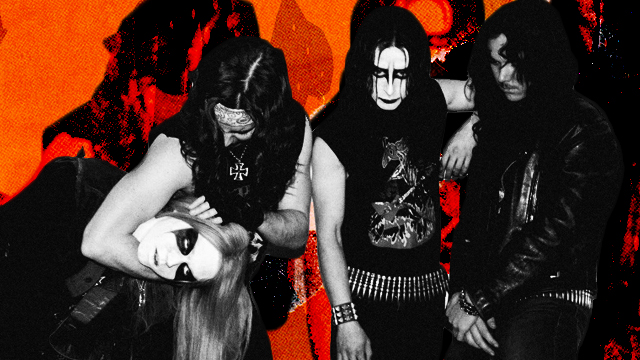
It’s hard to remember now where it was I read that first article on Norwegian black metal back in the ’90s because since then I’ve read and watched everything I could find on the subject. It’s an irresistible story, lurid and somehow equal parts goofy and macabre. Some Norwegian kids got into satanic heavy metal, took it way too far, burnt down ancient churches, put an actual headless suicide corpse on an album cover, and eventually started killing each other. Ahh, the music business!
It’s that story, of Euronymous, the band Mayhem, the record store Hell, Varg Vikernes aka Count Grishnackh, Death, and the whole Norwegian black metal gang, that director Jonas Akerlund (Spun) and his co-writer Dennis Magnusson set out to tell in Lords Of Chaos (adapting from Michael Moynihan and Didrik Søderlind’s book, though they didn’t keep much beyond the title and information from some of the primary source interviews).
The film has apparently been in development for quite some time, and for good reason: the details of this story are unforgettable. It’s hard to hear any of it without wishing it was a movie. At some point in the early ’90s, there was a Norwegian black metal band called “Mayhem.” When its singer, Dead — who used to bury his stage clothes and dig them up before shows so that he could more authentically embody his stage name, and was known to huff a dead bird he kept in a bag — blew his head off with a shotgun one day, his guitarist, Euronymous, took pictures of Dead’s corpse and made it Mayhem’s next album cover. There were other, more lurid rumors as well — about Euronymous eating Dead’s brains, about him making necklaces out of the pieces of Dead’s skull. These were comfortable, middle-class Norwegian kids from stable families who did all this seemingly because they were just really bored. And that’s just the beginning of the story.
The obvious challenge for depicting this kind of material is tone. This story can either be incredibly serious or incredibly goofy — kids who had evil lurking within them all along, or kids who just got way too into a goofy subculture. Akerlund, with Rory Culkin narrating as Euronymous (that’s the Culkin from Waco, not the Culkin from Succession) smartly takes the “Glenn Danzig buying kitty litter” approach to this material.
You can be both disturbed and impressed by the principal characters’ commitment to evil, but that just makes it funnier to see them do the unavoidable normie stuff like buy kitty litter or eat pancakes with mom. One of the underpublicized aspects of this whole story is that most of the Norwegian black metal crew was living with, and largely bankrolled by, their parents, even as they burnt churches, threw raw pig’s heads to their audience (who as depicted in the movie, devoured them), and pledged allegiance to LORD SATAN. Jonas Akerlund, who was the original drummer in the Swedish proto-black metal band Bathory before he became a full-time filmmaker, probably has unique insight into these characters.
Emory Cohen plays the other major player in the story, Varg Vikernes, aka Count Grishnackh. Cohen, who was so perfect as a meathead guido in The Place Beyond The Pines and later as the young version of your grandpa in Brooklyn, is once again completely unrecognizable from previous roles, as the initially pathetic, eventually terrifying Varg Vikernes.
Lords of Chaos‘ take on Vikernes is a novel one, especially as Varg likes to present himself as something of an intellectual anti-Christian Nazi pagan these days. In Akerlund’s telling, Vikernes seems to embody Gore Vidal’s famous take on Teddy Roosevelt: “give a sissy a gun and he will kill everything in sight.”
Varg first arrives as “Christian,” and in mocking Christian’s Scorpions patch, Euronymous seems to create a monster. Akerlund depicts this interaction perfectly, with Culkin’s Euronymous walking up to Cohen’s pear-shaped Christian, poking his Scorpions patch and saying, simply, “Scorpions.” It’s so much worse that he doesn’t need to voice his criticisms to make Christian feel embarrassed for liking them. Christian knows at some level that they’re embarrassing, and making Christian come to this conclusion on his own cuts so much deeper. It’s beautifully done, and says so much about fan culture.
In metal, as in many subcultures, the worst thing one could be was a poseur. It’s a very male post-adolescent thing (and possibly a particularly white male post-adolescent thing) to claim a series of increasingly ridiculous affectations as your identity and then deem anyone else who does it inauthentic. Which is even more pronounced when the subculture in question is death metal. Is there any way to authentically worship death without actually blowing your head off like Dead? It’s the obvious, unspoken question hanging over them at all times, driving them to greater and greater extremes to try to prove something that can never be proven.
It’s the inherent contradiction of their ideology and the constant drive to one-up each other as the most authentic that drives the story forward. Just as in all the other versions of this story, it’s fascinating. Akerlund perhaps could’ve done more to contextualize the saga of Norwegian black metal, to get at exactly why we can’t stop talking about it even 20 years later, but he does an excellent job hitting a tone that suits the material. He also doesn’t follow the story all the way through to now either, when Varg has become a free man and apparently a boring YouTuber (which is somehow both disappointing and fitting).
Still, I was happy to devour everything I could find about the story before, and I still am. To not screw up a story we already know is a feat in itself.






